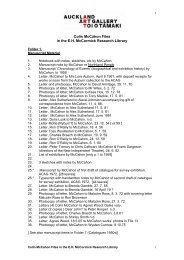You also want an ePaper? Increase the reach of your titles
YUMPU automatically turns print PDFs into web optimized ePapers that Google loves.
PlasticFrom Barbie dolls to spacesuits, plasticis found in an increasing proportion ofmaterials in museum and private collectionstoday. But the problems associatedwith the preservation of thesecomplex materials are many.Plastics are made from long-chainmolecules or polymers that are normallyorganic; that is, the chain is composedmainly of carbon atoms.Although polymers exist widely innature in, for example, wood, leather,horn and parchment, the use of modified natural polymers,new polymers or synthesised naturally occurringpolymers has resulted in a wide variety of new plasticmaterials.Plastics are divided into two main categories, thermoplasticand thermosetting. Thermoplastics are normallyshaped by heat and pressure and will soften andflow if reheated. Thermosetting plastics are hard andoften brittle compared to most thermoplastics, althoughthere are exceptions such as polystyrene, which is ahard brittle thermoplastic, and rubbers, which are a specialclass of thermosetting polymer.Causes of DeteriorationMost plastics are inherently unstable in the long termand their life will be considerably reduced if they arekept under the wrong conditions. As it is not possible toeliminate all the causes of deteriorationto plastics, it is necessary to controlexposure to these factors.Identification of the type of plasticand regular inspection of its conditionwill enable some of the causes of prematuredeterioration to be avoided.Light—is damaging to all plastics andshould be excluded or kept to a minimum.Even if the ultraviolet componentis removed, light levels should be keptas low as possible. Light can cause yellowingor changes to the colourant and well as initiatechemical deterioration of the structure.Relative Humidity—most plastics absorb moistureto a certain degree and so the maintenance of a stablehumidity is important to prevent the building up ofinternal stresses.Cellulosic materials, such as cellulose nitrate andcellulose acetate, should be kept at a low relative humidity,ideally below 40%, because moisture is a major factorin their deterioration.Materials such as casein and nylon, because of theirhigh moisture content, become brittle and subject tostress if the humidity levels become too low; they arebetter kept at around 60% relative humidity.High levels of humidity should be avoided to slowthe acidic by-products of deterioration and preventmould growth.51
















